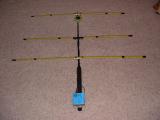
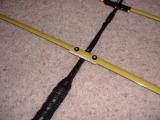
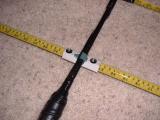
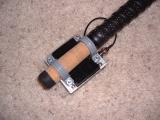
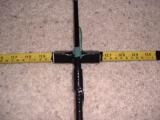
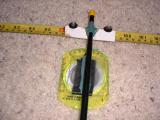
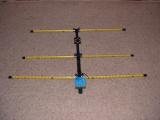
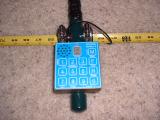
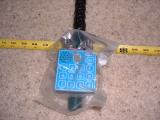
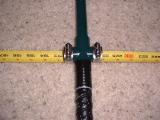
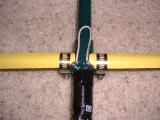
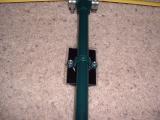
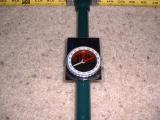
This year, Jen W5JEN and I built or rebuilt tape measure yagis for ARDF. These are based on the WB2HOL design. I reused the PVC in my old tape measure yagi, added 5" to the rear of the boom, and used PVC pipe hangers to mount a plexiglass plate for the receiver. I replaced the elements with fresh 1" steel tape, and used RG-174 feedline instead of RG-58 (I actually have a die set for RG-174 BNCs for my crimping tool.) With the smaller coax, it was easy to wrap 10 or more turns around the boom right at the feed point to form a choke balun - this kept the pattern from being skewed to one side. We wrapped the rest of the boom between the driven element and the reflector with tennis racquet tape (it happened to be a good balance point as well,) and mounted another small plexiglass plate between the driven element and the director, to which I had attached a baseplate compass.
Jen built a new tape-measure yagi, using a modified fishing rod with a cork grip for the boom. The boom-to-element brackets were quarter-round wood trim (which matched the curvature of the 3/4" tape measure,) notched and epoxied onto the fishing pole. The steel tape was attached to the wood by nylon screws (and some Scotch 33+!) She used two layers of steel tape near the middle for reinforcement. Her antenna also used RG-174 for the feedline and had a current balun wound around the boom as well. She mounted a compass plate between the driven element and the director using more epoxy. Because the fishing pole grip was really long, mounting the receiver plate at the end of the grip still left room to hold the antenna between the receiver and the reflector, which also happened to be a good balance point. Her yagi is noticably lighter than mine. I think a fishing pole boom might be the best way to go - but maybe we haven't quite found the best boom-to-element mounting solution yet.
These photos are copyright © 2004 Kenneth E. Harker. All rights reserved.
 |
W5JEN's yagi, made with a modified fishing pole as a boom. The steel tape measure used is 3/4" wide, and is doubled in the center for durability. |
 |
The boom to element connection is made with a short length of quarter round wood trim, to which the steel tape measure is bolted. Jen used nylon screws and rubber washers. |
 |
The other side of the boom to element bracket. A small notch was carved out of the wood, which was epoxied to the fishing pole. |
 |
The underside of the plexiglass plate used for mounting the receiver. The plate is held on with two 3/4" PVC pipe hangers. The receiver is attached to the plate with Velcro. |
 |
The driven element of W5JEN's yagi was held in place mostly by Scotch 33+ electrical tape. You can also see the tightly-wound choke balun in the RG-174 feedline. |
 |
This is the director of the yagi, attached with the quarter round wood trim and epoxy. Also, a plexiglass plate to hold a compass was epoxied onto the boom, and the compass was attached with Velcro. |
 |
WM5R's tape measure yagi uses 1/2" PVC for the boom, to which the elements attach with hose clamps. The steel tape measure used is 1" wide. The ends have been dipped five or six times in Plasti-Dip to cover the sharp edges. The boom was painted Hunter Green with Krylon Fusion paint. |
 |
The VK3YNG Foxhunt Sniffer Mk. 4 receiver is attached with Velcro to a plexiglass plate mounted behind the reflector. |
 |
A one quart Ziploc Freezer Bag, while not providing complete waterproofing, is the perfect size for handling light rain or wet vegetation out in the woods. A rubber band holds the bag in place. Make sure that the side of the bag with the white stripe (intended for writing on) is on the underside. |
 |
This is the driven element of the yagi. Each side of the element is held in place by a single hose clamp. The choke balun, formed by winding several turns of the RG-174 coax feedline, in held in place by Scotch 33+ electrical tape. The tennis racquet grip tape is Wilson Sports Contour. |
 |
The underside of the driven element is where the feedline and the hairpin match are soldered. |
 |
Between the driven element and the director of WM5R's yagi, a plexiglass plate is mounted using a single 1/2" PVC pipe hanger. A compass is then attached to the plate with Velcro. |
 |
Ken chose to pute a reverse bezel on the compass, using the graphics image at Charles NZ0I's website. He scaled the image to the appropriate size for the compass, cut out the ring very carefully, and affixed it to the compass with clear packing tape. |
|
Last Updated 26 June 2020 wm5r@wm5r.org |